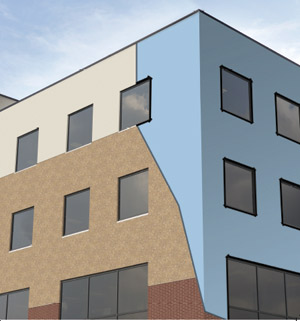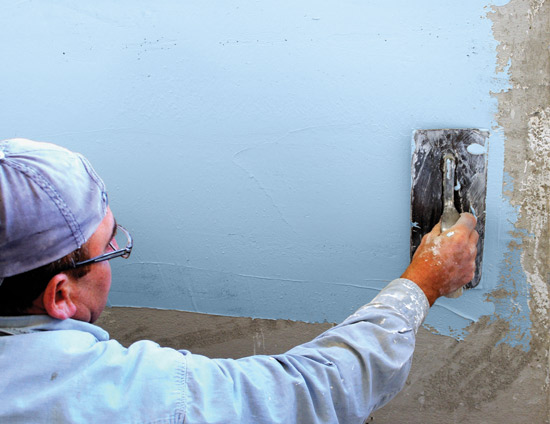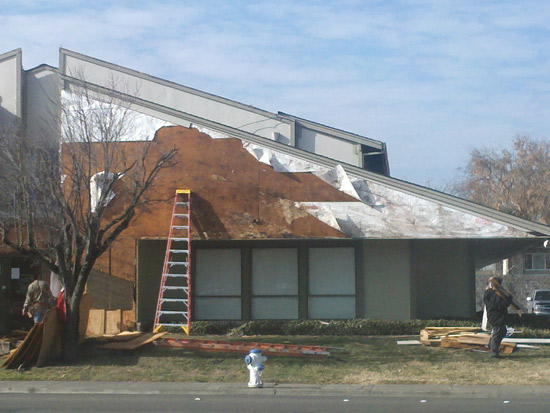Combination Air and Water-Resistive Barriers in Exterior Walls
Air Barrier Association of America—Offering Clarity

Photo courtesy of Dryvit Systems, Inc.
Continuity of an air barrier (shown in blue under final cladding) is required across all floors, around all openings, and at all penetrations.
The Air Barrier Association of America (ABAA) is a not-for-profit trade organization dedicated to advancing knowledge about air barriers. Founded in 2001, it is a membership-based association with a diverse makeup of manufacturers, suppliers, distributors, architects, engineers, contractors, researchers, testing and audit agencies, consultants, and building owners. While their first focus has been on air barriers, they more recently have begun to address water-resistive barriers as well. The association seeks to raise the standard of proficiency and effectiveness of the industry through quality assurance programs, education, lobbying, and marketing of the industry to government, the professional community, building owners, utilities, and other industry stakeholders. Among the messages they have conveyed, they point out that the U.S. Department of Energy has stated that up to 40 percent of the energy used to heat and cool a building is due to uncontrolled air leakage.
ABAA has become recognized as a go-to source for all things related to air barriers by the general design, construction, and manufacturing community. For design professionals, they provide technical information on air barriers, guide specifications, and accredited continuing education on relevant topics. For manufacturers they offer a product evaluation process whereby manufactured air barriers and/or water-resistive barriers and assemblies can be accredited and approved by the ABAA. In this regard they indicate that the performance of an air barrier assembly is of far greater importance than the air permeance of an individual material since a highly rated material won't matter much if the joints, seams, and penetrations are letting air through. For contractors and installers, they offer quality assurance training for field-installed systems including accreditation and certification for those who demonstrate proficiency. In short, they have become the recognized certification source for all aspects of designing, manufacturing, and installing air barriers and water-resistive barriers in thermal envelopes.
Conventional Barrier Materials
All of these criteria are important and establish the basis for performance and code compliance, but ultimately it comes down to selecting and using certain materials in a wall construction assembly. As might be expected, there are numerous choices that have been traditionally used and accepted for each of the barrier systems we are discussing. It is worth pointing out that different materials can provide a singular air barrier function, a vapor barrier function, or a water-resistive barrier function. There are also materials that can provide a combination of two or even all of these three functions.

Photo courtesy of Dryvit Systems, Inc.
Fluid-applied membrane systems can be applied to an appropriate substrate by using a trowel, a roller, or a sprayer as field conditions may warrant.
Common Vapor Barriers
The IBC recognizes that there has been considerable discussion and debate over what is an acceptable vapor barrier material. It therefore first allows certified testing of a material or assembly to demonstrate the perm ratings of the three different vapor retarder classes. In addition the IBC identifies specific acceptable materials for each Class: (IBC 1405.3.2)
▶ Class I: Sheet polyethylene, non-perforated aluminum foil.
▶ Class II: Kraft-faced fiberglass batts or paint with a perm rating greater than 0.1 and less than or equal to 1.0.
▶ Class III: Latex or enamel paint.
By virtue of this language, the materials listed above have become commonly used where required or appropriate on the inside of framed walls.
Common Water-Resistive Barriers (WRB)
The IBC identifies two options for WRB materials, first stating: “A minimum of one layer of No. 15 asphalt felt, complying with ASTM D 226 for Type 1 felt…” (IBC 1404.2). Asphalt felt has certainly been a traditional material for many thermal envelope installations including walls and roofs, however it is seen as a rather obsolete material compared to other modern alternatives. The second IBC option is to allow “other approved materials” which refers to “materials that are acceptable to the building official or authority having jurisdiction” (IBC 202) rather than a long list of alternatives. Approval will certainly include demonstrated compliance with air barrier performance but in many applicable cases, also with fire performance as part of an assembly tested by NFPA 285.
Among the more commonly used and approved materials, self-adhered sheet membranes (sometimes call “peel and stick” materials) are prevalent. These have traditionally been used in roofing applications and were also popular on below-grade walls. However, there are a variety of manufacturers and products such that performance varies considerably meaning that they may or may not work as effective water-resistive barriers or effective air barriers for above-grade walls. Another concern is the vapor permeability of these materials. Vapor barriers are required by the IBC on the inside of framed walls (for cold climates) in most cases, not the outside where WRBs are typically required. Hence, if any vapor does make it into the wall it is prevented from escaping to either the inside or outside thus becoming counter-productive to the intent of protecting the wall construction. A class III vapor permeable WRB is preferable then to allow any trapped moisture to migrate out while still protecting the wall from water. Hence the use of self-adhered sheet membranes is also becoming rather obsolete in walls in favor of other approved materials that have a more desirable vapor permeability rating. Among them are mechanically attached flexible sheets made of non-woven materials that can provide water resistance and may also function as an air barrier depending on the manufacturer and product. Of course, the penetration of the mechanical fasteners compromises the continuity of the barrier and different manufacturers try to address that in different ways, some with better success than others.
Common Air Barrier Materials
The ABAA recognizes several categories of material types, namely self-adhered sheet air barriers, liquid-applied membranes, medium-density sprayed polyurethane foam, mechanically fastened commercial building wraps, and board-stock air barriers. They will test and certify all of these recognizing that they can all perform well if installed properly using air barrier accessories (i.e. sealants, tapes, and transition membranes) assembled together to form a continuous barrier. However, there are practical limits and other considerations in particular building projects that can determine which type will work best. The IECC recognizes this and allows tested demonstration of performance but also lists no less than 15 different common construction materials that can be treated as acceptable air barriers “provided joints are sealed and materials are installed as air barriers in accordance with the manufacturer's instructions” (IECC C402.4.1.2.1). These materials are consistent with the ABAA categories and include such things as plywood or OSB, foam insulation, gypsum or cement board, roof membranes, concrete products, or metal. While it is easy to see that any of these would certainly inhibit or prevent air flow, the issue of course is the edges and penetrations. There is also the concern of trapped moisture being able to escape since many of these materials will have the same concern as non-permeable WRBs. For these reasons it is easy to see why it has become so common to use a separate sheet over these conventional construction materials to act as a continuous air barrier with some vapor permeability. As noted, some of these sheet products can also double as a water-resistive barrier depending on the manufacturer or product.

Photo courtesy of Dryvit Systems, Inc.
Conventional sheet type air and water-resistive barriers have limitations based on the method of attachment and sealing of seams and joints.









